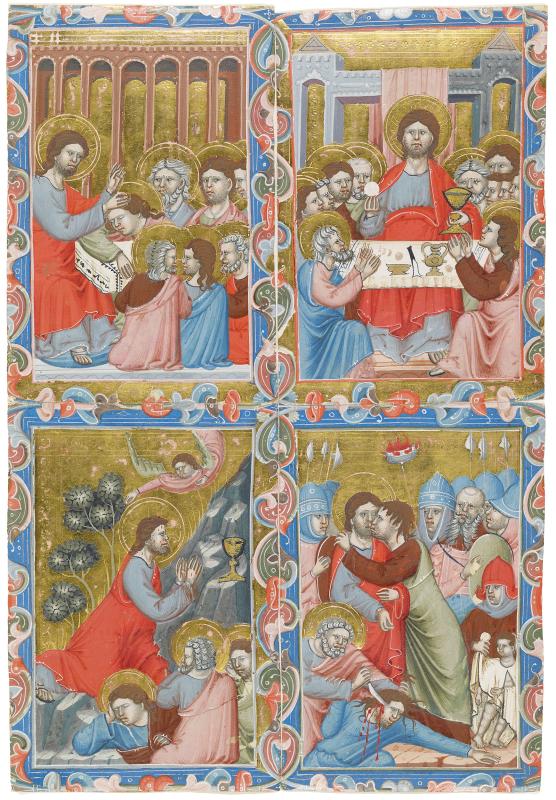
Ms. saints' legends, written and illuminated in Bologna, Italy, or Hungary, ca. 1325-1335.
Decoration: 93 individual images, of which 2 quadripartite miniatures (8 individual images) are in their original format on 2 uncut but marginally cropped leaves (M.360.25, M.360.26); 17 quadripartite miniatures have been fully reconstituted from 68 individual images (cuttings); and 6 quadripartite miniatures have been partially reconstituted from 13 individual images (cuttings). Additionally, M.360.16a-d consists of 4 individual images (cuttings), matted together, from 3 original miniatures.
Artist: Hungarian Master and workshop.
Other known portions of the original Legendary are found in the following collections: 1) Vatican City, Biblioteca Apostolica Vaticana, MS Vat. Lat. 8541 is the largest surviving portion, consisting of 105 leaves with quadripartite miniatures, each section of the miniatures accompanied by a short inscription in Latin. There is no proof that this portion of the Legendary was ever in the hands of Giovanni Battista Saluzzo; a 17th-century foliation indicates that there had been at least 16 additional folios, removed some time between the time of foliation and the binding of this fragment for presentation to pope Benedict XIV (Lambertini, 1740-1758), who gave it to the Museo Cristiano in 1757, and from there it entered the Vatican Library; 2) Leningrad, The Hermitage, MSS E 16930-16934, comprising five cropped leaves of undivided quadripartite miniatures; 3) New York, Metropolitan Museum of Art, MS 199.516; one cropped leaf (219 x 168 mm) of undivided quadripartite miniatures. Provenance: 1630-1642 - Giovanni Battista Saluzzo; 1740-1758 - Pope Benedict XIV [Lambertini]; Gabriele Laureani, Prefect of the Vatican; purchased from Laureani's estate by Giulio Sterbini in 1845; Léonce Rosenberg , Catalogue June-July 1913, #73; next found among the diverse materials of an extra-illustrated first edition of Dibdin's The Bibliographical Decameron owned by Mrs. Walter P. Bliss, New York and Bernardsville, N.J.; her estate sale (New York, Parke Bernet, 12 December 1961 lot 68) to John F. Fleming; purchased ca. 1969 from Fleming by Edwin L. Weisl, Jr. of New York; Edward R. Lubin catalogue: European Illuminated Manuscripts, [1985], no. 18; Gift of Mr. and Mrs. Edwin L. Weisl Jr. to the MMA in 1994; 4) Berkeley, University of California, Bancroft Library, Special Collections, MS 2MS A2M2 1300:37, one cropped leaf of undivided quadripartite miniatures; 5) Paris, Louvre, Cabinet des Dessins, R.F. 29940, one cropped leaf of undivided quadripartite miniatures, 220 x 165 mm., catalogued under "Ecole d'Italie", representing the Legend of St. Francis, a companion to the MMA leaf.
Individual images from M.360.1-24 were previously mounted in a small brown morocco album (preserved in the Morgan Library) by Giovanni Battista Saluzzo (1579-1642) who owned the manuscript in the 17th century. Saluzzo cut apart the leaves, separating them into the four individual units (images) of their original quadripartite format, trimmed off the rubrics and transcribed them onto each verso, and then mounted each individual cutting on a paper folio (85 total), framing it with a paper mat, providing captions in Italian (written above) and Latin (written below). The reconstituted leaves and M.360.25-26 are now matted.
It has been suggested that these surviving miniatures represent no more than two-thirds of their original number, and were probably preceded by a dedicatory and textual section. Of the 59 stories illustrated in the Legendary, 2 are based on Bible texts, 50 are extracted from the standard Legenda aurea and 5 from its Hungarian appendix; for two - the legends of St. Francis and St. Ladislaw - the exact textual precedent is not known. In terms of its organization (as reconstituted in facsimile form), the compiler of the legends eschewed the chronological order of the Church calendar and substituted social structure. The Legendary begins with the stories of Christ and the Virgin, followed by the story of John the Baptist, and then the Apostles, who are presented in the order established in the Litany. In succession come the Martyrs, the Confessors, the Virgins, and finally the Female saints.
Magyar Anjou legendary single leaves
